Planting garden blueberry seedlings in open ground in spring
Blueberries are still a new (rare) crop in our summer cottages and backyards. This berry plant is relatively unpretentious in care (although it loves watering very much) and winters well in harsh conditions, but it is very demanding on the soil (it must always be acidic). Therefore, if you want to feast on delicious and healthy berries grown with your own hands, then first of all you need to properly plant blueberries in your garden.
Well, let's understand the timing and nuances of spring planting of blueberries.

Content
- 1 When to plant blueberries in spring, in what month: optimal timing
- 2 How to plant blueberries in spring: features and step-by-step instructions
- 2.1 What should be a seedling
- 2.2 Landing place
- 2.3 What soil is needed
- 2.4 How deep to plant or what should be the landing hole
- 2.5 How to fill the planting hole: what fertilizers can be added
- 2.6 At what distance to plant
- 2.7 What should be the correct neighborhood, and what should not be planted next to
- 2.8 How to prepare a container seedling for open field planting
- 2.9 Direct landing
- 3 Blueberry care after spring planting
- 4 Possible mistakes when planting blueberries
When to plant blueberries in spring, in what month: optimal timing
It is recommended to plant blueberries with an open root system in early spring, before sap flow (before the buds swell). It is best to plant soon after the snow has melted, when the ground is still wet and the soil warms up to about +5 degrees.
Depending on the weather conditions and climatic characteristics of the growing region, the time for planting shrubs begins in March-April and lasts until May: in the Central Lane (Moscow region) - in about April, in the South of Russia - earlier, but in the North-West (Leningrad region ), The Urals and Siberia begin to plant blueberries not earlier than May.
By the way! If you purchased a seedling in a container, i.e. with a closed root system (ZKS), and it is in this form that blueberries are often sold, then it can be planted in open ground throughout the year, because in this case, the root system will suffer minimally. It is not recommended to do this in the middle of summer, when it is very hot.
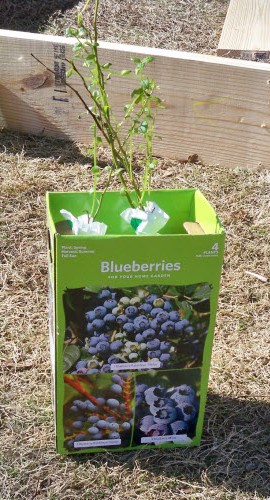
You can plant garden blueberries in a permanent place both in autumn and spring, but spring planting is still preferable.
According to the lunar calendar in 2020
Choosing the optimal date for planting seedlings can help you moon calendar.
So, favorable days for spring planting of blueberries in 2020, according to the lunar calendar, are:
- in March - 26-29;
- in April - 11-15, 24, 25;
- in May - 2-10.
Of course, it is not always possible to get to the dacha on favorable days, so the main thing is not to plant blueberries on unfavorable dates according to the lunar calendar - the days of the New Moon and Full Moon, as well as the period when the Moon is in Aquarius, because it is a barren and dry sign -in italics.
Unfavorable days, according to the lunar calendar, for 2020 for planting blueberry seedlings in spring, the following dates are:
- in March - 9,19-21, 24;
- in April - 8,15-17, 23;
- in May - 7,13-14, 22;
- in June - 5,9-11, 21.
According to the lunar calendar, from the magazine "1000 Tips for Summer Residents".
How to plant blueberries in spring: features and step-by-step instructions
If most plants can tolerate improper planting, then the yield directly depends on whether blueberries were planted correctly. The thing is that a capricious plant normally develops only in an acidic environment, which is recommended to be created, so to speak, with your own hands. Let us examine all the nuances of landing in order.
What should be a seedling
A high-quality blueberry seedling must meet the following parameters and characteristics:
- It is best to use 2 and 3-year-old seedlings as planting material, which have a good one-year growth and strong last year's (or 2-year-old) branches.
- The appearance of the seedling must be healthy: the plant must not have any foci of disease (spots) or mechanical damage.
- For seedlings with a closed root system, the roots should be visible from the drainage holes of the container, or they should be clearly visible when you pull the earthen ball out of the container.
Advice! Naturally, it is optimal to purchase varieties adapted to your climatic characteristics, in other words, zoned. Only in this case can you get stable and excellent yields.
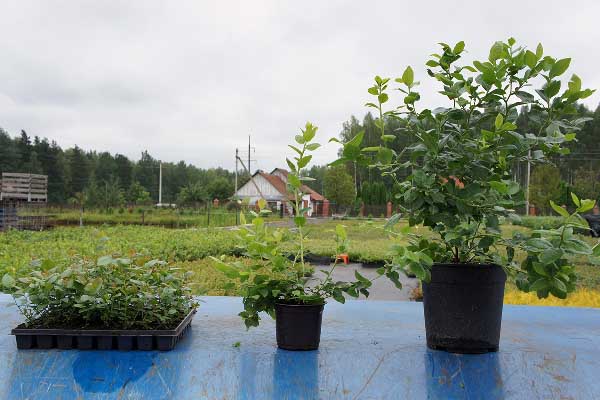
Video: how to choose blueberry seedlings
Landing place
To plant blueberries, choose an open and well-lit (sunny) place.
It is impossible to plant a bush in the shade: due to a lack of sunlight, the berries will become small and sour.
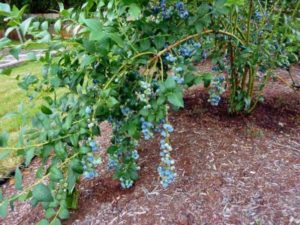
Do not plant blueberries in lowlands (especially if the soil freezes in spring) or in areas where there is a high level of groundwater.
Advice! If you have excessively heavy (clay) soil, or the only place in the lowland, or groundwater lies close to the surface, then it is better to plant blueberries on an artificial hill (knoll).
Video: why plant blueberries in high beds
What soil is needed
Blueberries will grow well only in very acidic peat soils (pH 3.5-4.5), preferably a loose and light structure, including sandy soils.In other words, the soil must be well permeable to water and enriched with air, i.e. sufficiently aerated.
Therefore, for the cultivation of this forest berry shrub in a summer cottage, it is necessary to completely replace the garden land with a special acidic soil (based on sour peat and sand).
Of course, a less successful option for planting blueberries (and almost all plants) is heavy (clay) soil... In this case, you will need to add more sand to the soil mixture and be sure to fill in a more powerful drainage layer, and therefore, dig a deeper planting hole.

Why do blueberries grow well only on acidic soil! The fact is that there are no root hairs on the roots of blueberries, so they develop in close symbiosis (symbiotic relationship) with such a specific type of fungus as ericoid mycorrhiza, which helps the plant absorb nutrients from the soil, and it lives only at low acidity. In other words, the acidic environment is needed not by the blueberries themselves, but by the mycorrhiza, which is located on the roots of the blueberries.
How deep to plant or what should be the landing hole
To plant blueberries, it is necessary to dig and prepare a planting hole 40-60 centimeters deep and the same width (diameter).
By the way! The average size of a planting pit for blueberries is 50 to 50 cm.
Although some gardeners recommend increasing the width to 80-90 cm (after all, blueberry roots grow well in breadth).

Advice! To fence off blueberries from garden soil, it is optimal to build the sides around the landing pit (trench) using any durable material (wood, stone, plastic, brick, slate), and lay the bottom of the landing pit with geotextiles. In this way, Thanks to artificial isolation, the risk of blueberry roots coming into contact with your garden soil will disappear, and the soil itself will not become acidic.
Idea! Alternatively, you can use an old 200-liter plastic barrel after cutting it in half.
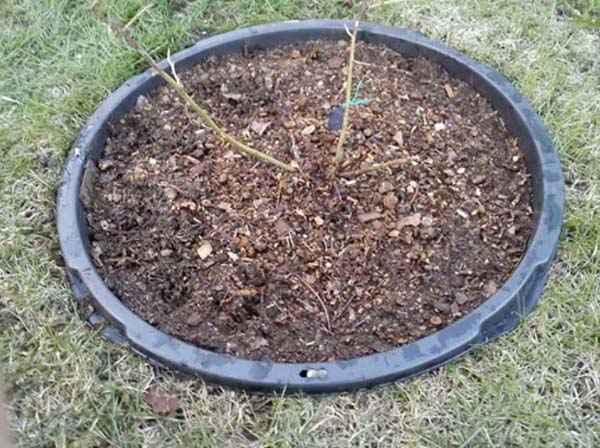
Further, it immediately fits to the bottom drainage layer 10-20 cm (if the soil is clayey - more, light - less), and then the prepared nutrient mixture is poured.
It is optimal to use the most ordinary logs or large coniferous bark as drainage, but in no case lime or chalk crushed stone (it will, on the contrary, lower the acidity of the soil).

Important! If you have to plant in excessively clayey soil, then, in addition to the obligatory drainage layer, you also need to dig the deepest hole possible (at least 50 cm, and better - 60-90 cm).
Video: how to properly prepare a blueberry planting pit
By the way! Blueberries can be planted both in individual planting pits and in trenches (convenient if you want to plant many bushes at once).
How to fill the planting hole: what fertilizers can be added
Next, the planting hole must be filled with a fertile and necessarily acidic substrate (3.5-4.5 pH).
Advice! To check whether it was possible to prepare the soil of the required acidity, you need to determine its acidity in one of the possible ways.

Alternatively, blueberry potting soil can be composed of the following components:
- high-moor sour peat (based on red bog peat, somewhere 40-60%);
- coniferous litter (rotted coniferous needles, about 20-40%);
- yellow sand (about 10-30%).
You can also additionally add such an acidic mineral fertilizer to the substrate as ammonium sulfate, which contains not only nitrogen, but also sulfur (is an excellent acidifier), or just sulfur (for example, colloidal).
And if you are a "lazy" summer resident who does not want to bother with preparing a special soil mixture, then you can purchase ready-made soil for blueberries. For example:
- «Aeration soil for blueberries and forest berries "from the Bona Forte company and the like.

Note! Blueberries do not like any organic matter (compost, humus), they are destructive for them, because alkalizes the soil.Another thing is pine litter (necessarily rotted) or softwood sawdust.
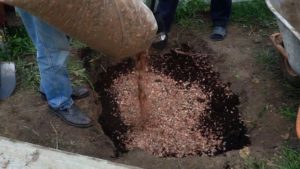
Advice! Or you can even dig up land from the swampy area where forest blueberries grow.
At what distance to plant
Blueberries do not like crowding, their roots grow in breadth, along the perimeter of the crown, therefore, garden blueberry bushes (tall) are planted at a distance of 1-1.5 meters from each other, and between rows - 1.5-2 meters.
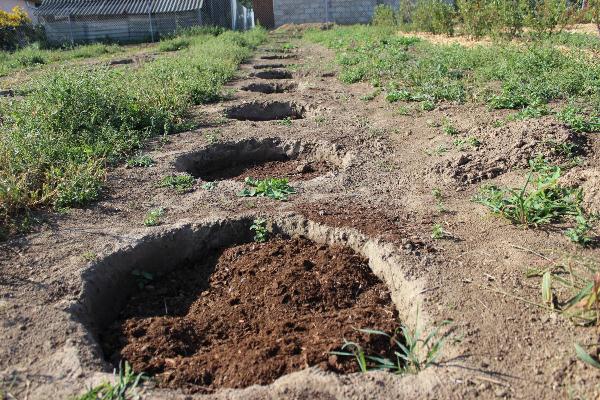
What should be the correct neighborhood, and with what can not be planted next
Due to the fact that blueberries do not tolerate organic fertilizers (humus, compost), it is strictly forbidden to plant it next to most cultivated plants that are regularly fed with alkaline organic fertilizers.
For example, for blueberries, raspberries, currants, gooseberries are completely unsuitable neighbors.
It is best to plant blueberries either next to forest berry bushes, i.e. cranberries, lingonberries, or with such flowering shrubs as azaleas, rhododendrons, in other words, next to heather crops that love acidic soil.
How to prepare a container seedling for open field planting
As a rule, if you have a container seedling, then it is advised to simply carefully remove it from the container, without disturbing the earthy coma, and plant it in a specially prepared planting pit.
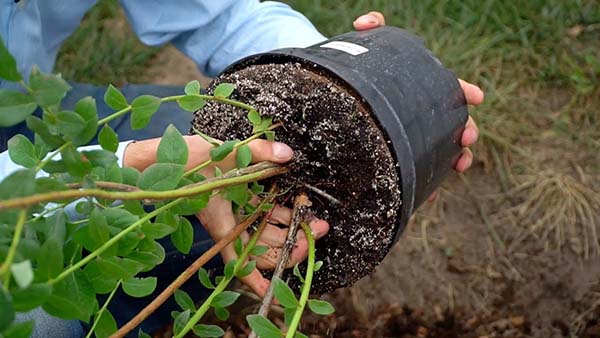
However, before you plant a blueberry seedling with a closed root system in a new place, it is recommended to do something with it, or rather with its roots in an earthen coma.
A first spill well with water, to make it more convenient to manipulate the earthy clod and roots.
- After you take the seedling out of the container, you will definitely notice that its roots are, as it were, bent into the center of the earthen coma. To successfully root blueberries outdoors, you need translate them (roots) to a horizontal position, namely slightly knead the earthen lump (only the lower 5-7 cm) and spread the roots to the sides.
Note! If this is not done, then the roots will remain bent inward. And due to the fact that they are very thin and small, they simply cannot straighten themselves. As a result, after a while, your seedling may die ...
- In case you for some reason do not want or are afraid to touch the root system of the seedling, there is an alternative solution: you just need deepen the seedling when planting, that is, to plant 5-7 cm deeper than it grew in the container... As a result, after about a year, new roots will appear from young shoots, which will go into horizontal growth.
Direct landing
Step-by-step instructions for planting blueberry seedlings in open ground:
- Dig a planting hole and fill it halfway with nutritious soil.
- Make a small mound in the center, where to put the seedling, so that the roots can be gently spread along its (mound) sides.
By the way! If you decide to plant a container seedling without spreading the roots (but with deepening), then, of course, you need to plant it on a horizontal surface.
Remember! But seedlings with an open root system are always planted on mounds.
- Cover with prepared soil mixture and slightly compact the soil around the bush.
- Sprinkle with plenty of water (allow moisture to absorb, then water again).
- Top up the soil if it shrinks after watering.
- Mulch the seedling with sour mulch (sour peat, coniferous litter (needles), bark, coniferous sawdust or wood chips mixed with sand or hay) with a layer of 3-5 cm.
Note! You can mulch with hay only on rapidly drying soils, i.e. on the sandy. On clayey, even the same loams, this can lead to decay of blueberry roots.
Video: planting blueberries from A to Z
Blueberry care after spring planting
In order for a blueberry seedling to quickly and well take root in a new place, the first time after planting is necessary maintain sufficient humidity at all times, in other words, water regularly.

In the future, the following should be included in the main measures for caring for a pigeon in the garden:
- Regular and abundant watering... On the hottest summer days, watering is recommended frequently and by irrigation (sprinkling).
Advice! Watering is desirable with acidic water.
- Loosening and weeding from weeds. In order for the roots to grow quickly, they need to provide an influx of fresh air. Aeration can be improved by regular loosening and weeding.
Blueberry roots are close to the surface, so you need to loosen the soil no more than 5-6 cm.
- Mulching... Remember to periodically renew the mulch layer under the bushes.
Mulch will help avoid excessive evaporation of moisture and will slowly acidify the soil, and will also be able to equalize the temperature regime.
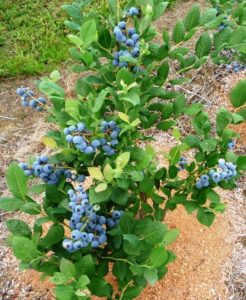
- Top dressing and obligatory regular (if necessary) soil acidification (remember that keeping the soil acidic is the most important thing when caring for blueberries).
By the way! The site has a detailed article about how to properly acidify and feed garden blueberries in spring, summer and autumn.

Advice! The best organic blueberry food is vermicompost, which is the compost that Californian worms helped create.
- Rejuvenating and regulating pruning (on adult bushes over 10-12 years old);
If you do not prune in the future, the bush will thicken over time, and the blueberries will simply be crushed and become sour.
The most suitable time for pruning blueberries is autumn, after leaf fall, or early spring, before the buds swell.
Video: garden blueberries - planting and care
Possible mistakes when planting blueberries
Having decided to grow garden blueberries (tall), not everyone has enough time to learn all the features of this plant. And even if the information was nevertheless studied, novice summer residents often make mistakes in the confusion of accumulated cases. The most popular ones are:
- Prepare a nutritious soil mixture without checking its acidity, including adding organic matter (humus).
- Do not fence off the seedling along the outer diameter of the planting pit from the garden soil (this is especially required if you have clay soil).
- Forget about drainage (especially on heavy soils).
- Do not mulch the trunk circle.
- Bushes are planted too close to each other.
- They forget to acidify the soil by making acidic watering and feeding.
Important! The optimum soil acidity for blueberries is 3.5-4.5 pH, the threshold is 5-5.5 pH, with more alkaline soil, the shrub becomes sick chlorosis - his leaves begin to turn yellow. The fact is that with such acidity, the plant ceases to receive nutrition from the roots, because mycorrhiza in these conditions simply does not work.

Thus, planting blueberries is a fairly complex undertaking that takes a lot of time and takes a lot of physical effort, which will pay off in full only if the procedure was performed in accordance with all the rules and recommendations. Good luck!
Remember! For blueberries to be sweet, the soil underneath must be acidic!
Video: technology of planting and caring for tall blueberries


If the ph of peat (the package says at least 2.5) can you plant blueberries in it? Or do you need to add something to increase the pH?
You can, you will in any case prepare the soil mixture, i.e. add other ingredients.